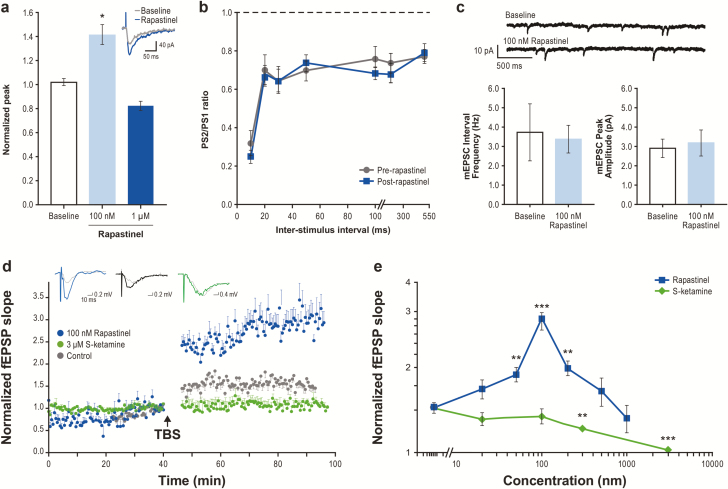Figure 6.
Rapastinel potentiates N-methyl-D-aspartate receptor (NMDAR)-mediated excitatory postsynaptic currents (EPSCs) and acutely enhances long-term potentiation (LTP) in medial prefrontal cortex (mPFC) pyramidal neurons. (A–C) Increase in the amplitude of pharmacologically-isolated NMDAR-mediated EPSCs with 100 nM or 1 μM rapastinel (A; n = 6, P < .05, paired t test) with no change in NMDAR current kinetics (inset), paired-pulse response profiles in the mPFC measured as ratio of the second population spike response to the first (PS2/PS1) (B: n = 9, P > .20, paired t test), or frequency or amplitude of spontaneous miniature EPSCs recorded in mPFC pyramidal neurons (C; n = 6, P > .20, paired t test). (D) Enhancement of the magnitude of LTP induction in mPFC slices by theta burst stimulus trains (TBS) and treated with 100 nM rapastinel starting 20 minutes prior to TBS (n = 8, P < .01, Fisher’s least significant difference [LSD] test; fEPSP, field excitatory postsynaptic currents) compared with slices treated with 3 μM S-ketamine (n = 7) and untreated control slices (n = 8). Inserts are representative signal averages of 4 fEPSPs before (dotted grey) and 47 to 50 minutes after TBS with 100 nM rapastinel (blue), control (black), or 3 μM S-ketamine (green). (E) Effects of varying concentrations of rapastinel and S-ketamine on LTP of excitatory postsynaptic potentials (n = 6–9 slices, **P < .01, ***P < .001 vs untreated control slice LTP, Fisher’s LSD test). Data are mean ± SEM.

